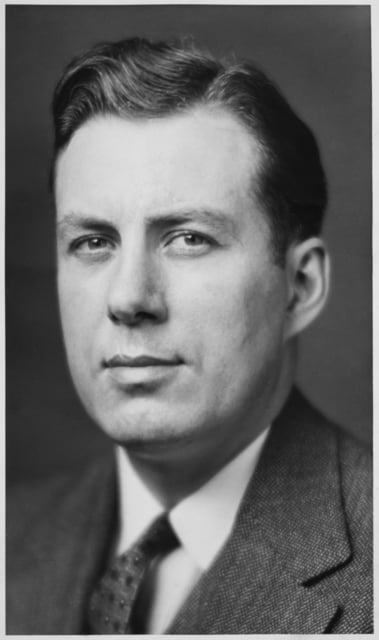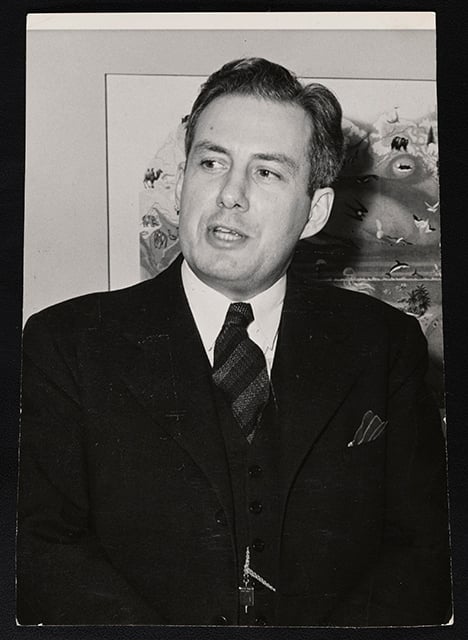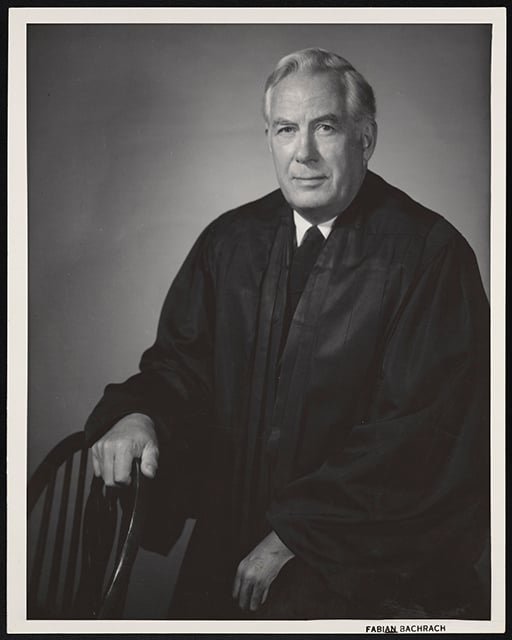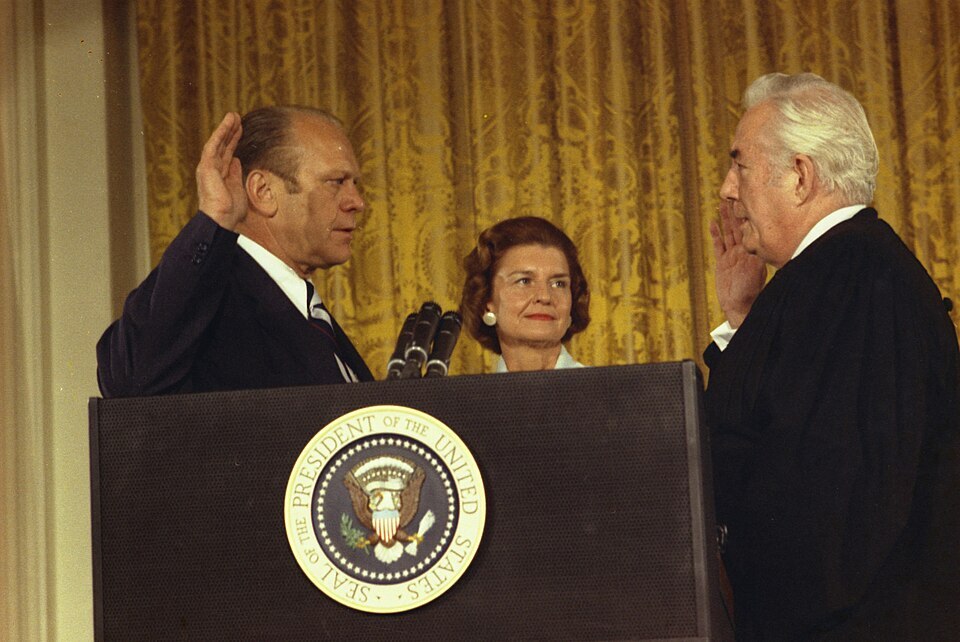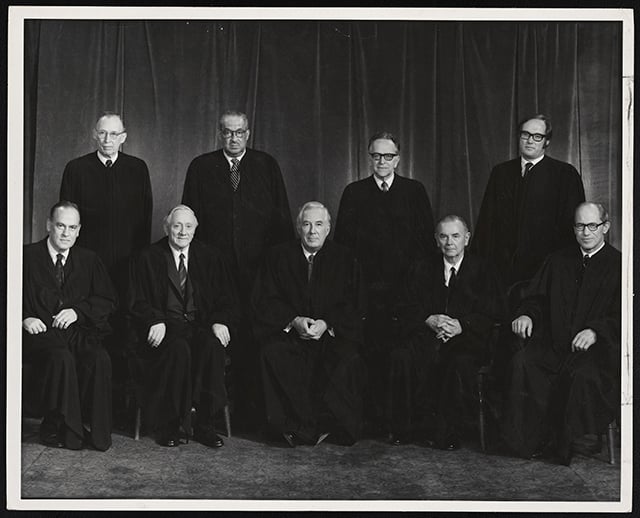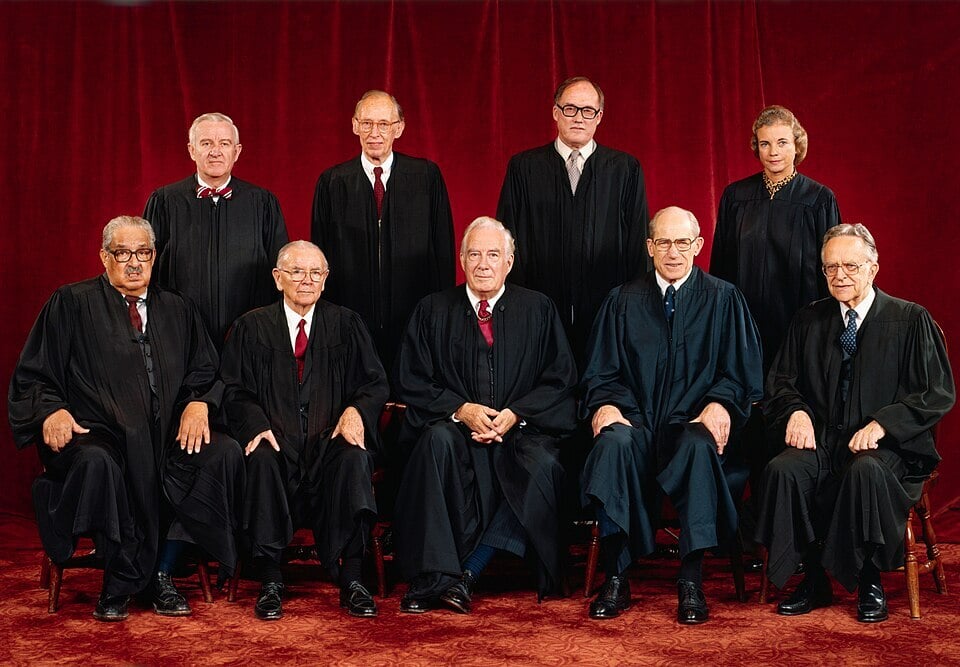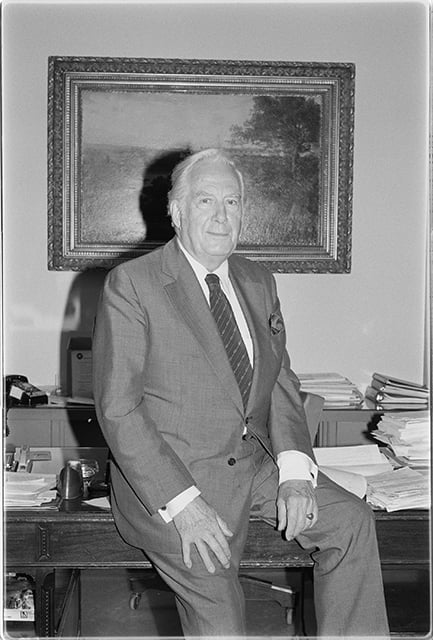Burger, Warren Earl (1907–1995)
Creator:
Paul Nelson
Bibliography
Blasi, Vincent, ed. The Burger Court: The Counter-Revolution That Wasn’t. Yale University, 1983.
Maltz, Earl M. The Chief Justiceship of Warren Burger, 1969–1986. University of South Carolina, 2000.
Mitchell Hamline History Center. “Warren E. Burger (1931).”
https://mitchellhamline.edu/history/biography/warren-e-burger-1931
Powell, Lewis F., Jr. “The Burger Court.” Washington and Lee Law Review 44, no. 1 (1987): 1–10.
https://scholarlycommons.law.wlu.edu/cgi/viewcontent.cgi?article=2776&context=wlulr
Schwartz, Herman, ed. The Burger Years: Rights and Wrongs in the Supreme Court, 1969–1986. Viking Penguin, 1987.
Supreme Court Historical Society. “The Burger Court, 1969–1987.”
https://supremecourthistory.org/history-of-the-courts/burger-court-1969-1986
Supreme Court Historical Society. “Warren E. Burger, 1969–1987.”
https://supremecourthistory.org/chief-justices/warren-burger-1969-1986
Tobias, Carl C. “Warren Burger and the Administration of Justice.” Villanova Law Review 41 (1996): 505–519.
https://scholarship.richmond.edu/cgi/viewcontent.cgi?article=1818&context=law-faculty-publications
Woodward, Bob, and Scott Armstrong. The Brethren: Inside the Supreme Court. Simon & Schuster, 1979.
Maltz, Earl M. The Chief Justiceship of Warren Burger, 1969–1986. University of South Carolina, 2000.
Mitchell Hamline History Center. “Warren E. Burger (1931).”
https://mitchellhamline.edu/history/biography/warren-e-burger-1931
Powell, Lewis F., Jr. “The Burger Court.” Washington and Lee Law Review 44, no. 1 (1987): 1–10.
https://scholarlycommons.law.wlu.edu/cgi/viewcontent.cgi?article=2776&context=wlulr
Schwartz, Herman, ed. The Burger Years: Rights and Wrongs in the Supreme Court, 1969–1986. Viking Penguin, 1987.
Supreme Court Historical Society. “The Burger Court, 1969–1987.”
https://supremecourthistory.org/history-of-the-courts/burger-court-1969-1986
Supreme Court Historical Society. “Warren E. Burger, 1969–1987.”
https://supremecourthistory.org/chief-justices/warren-burger-1969-1986
Tobias, Carl C. “Warren Burger and the Administration of Justice.” Villanova Law Review 41 (1996): 505–519.
https://scholarship.richmond.edu/cgi/viewcontent.cgi?article=1818&context=law-faculty-publications
Woodward, Bob, and Scott Armstrong. The Brethren: Inside the Supreme Court. Simon & Schuster, 1979.
Chronology
1931
Burger receives a law degree from St. Paul College of Law. He had attended the University of Minnesota but never earned a degree.
1944
Burger serves as presidential candidate Harold Stassen’s floor manager at the Republican National Convention.
1948
Burger manages Stassen’s presidential campaign.
1952
As chair of the Minnesota delegation at the Republican National Convention, Burger resolves a credentials dispute to the advantage of Dwight Eisenhower.
1953
President Eisenhower appoints Burger assistant US attorney general in charge of its civil division.
1955
Eisenhower appoints Burger to a seat on the US Court of Appeals for the District of Columbia Circuit. He is confirmed in 1956 and serves there for thirteen years.
1969
Burger is appointed to the US Supreme Court as chief justice and confirmed by a vote of 74 to 3. He succeeds Earl Warren.
1972
Burger dissents in Furman v. Georgia, in which the Court invalidates (temporarily, as it turned out) all death sentences in the United States.
1973
Burger votes with a 7-2 majority to find a constitutional right to abortion. He assigns former Mayo Clinic general counsel Harry Blackmun to write the majority opinion in Roe v. Wade.
1974
Burger votes with a unanimous court to deny President Nixon executive privilege over his office recordings related to the Watergate scandal. Though the opinion is a joint effort of several justices, it goes out over Burger’s signature.
1986
Burger, now seventy-nine years old, resigns from the court to lead the national celebration of 200 years since ratification of the Constitution.
1995
Burger dies in Washington, DC, and is buried in Arlington National Cemetery.
Bibliography
Blasi, Vincent, ed. The Burger Court: The Counter-Revolution That Wasn’t. Yale University, 1983.
Maltz, Earl M. The Chief Justiceship of Warren Burger, 1969–1986. University of South Carolina, 2000.
Mitchell Hamline History Center. “Warren E. Burger (1931).”
https://mitchellhamline.edu/history/biography/warren-e-burger-1931
Powell, Lewis F., Jr. “The Burger Court.” Washington and Lee Law Review 44, no. 1 (1987): 1–10.
https://scholarlycommons.law.wlu.edu/cgi/viewcontent.cgi?article=2776&context=wlulr
Schwartz, Herman, ed. The Burger Years: Rights and Wrongs in the Supreme Court, 1969–1986. Viking Penguin, 1987.
Supreme Court Historical Society. “The Burger Court, 1969–1987.”
https://supremecourthistory.org/history-of-the-courts/burger-court-1969-1986
Supreme Court Historical Society. “Warren E. Burger, 1969–1987.”
https://supremecourthistory.org/chief-justices/warren-burger-1969-1986
Tobias, Carl C. “Warren Burger and the Administration of Justice.” Villanova Law Review 41 (1996): 505–519.
https://scholarship.richmond.edu/cgi/viewcontent.cgi?article=1818&context=law-faculty-publications
Woodward, Bob, and Scott Armstrong. The Brethren: Inside the Supreme Court. Simon & Schuster, 1979.
Maltz, Earl M. The Chief Justiceship of Warren Burger, 1969–1986. University of South Carolina, 2000.
Mitchell Hamline History Center. “Warren E. Burger (1931).”
https://mitchellhamline.edu/history/biography/warren-e-burger-1931
Powell, Lewis F., Jr. “The Burger Court.” Washington and Lee Law Review 44, no. 1 (1987): 1–10.
https://scholarlycommons.law.wlu.edu/cgi/viewcontent.cgi?article=2776&context=wlulr
Schwartz, Herman, ed. The Burger Years: Rights and Wrongs in the Supreme Court, 1969–1986. Viking Penguin, 1987.
Supreme Court Historical Society. “The Burger Court, 1969–1987.”
https://supremecourthistory.org/history-of-the-courts/burger-court-1969-1986
Supreme Court Historical Society. “Warren E. Burger, 1969–1987.”
https://supremecourthistory.org/chief-justices/warren-burger-1969-1986
Tobias, Carl C. “Warren Burger and the Administration of Justice.” Villanova Law Review 41 (1996): 505–519.
https://scholarship.richmond.edu/cgi/viewcontent.cgi?article=1818&context=law-faculty-publications
Woodward, Bob, and Scott Armstrong. The Brethren: Inside the Supreme Court. Simon & Schuster, 1979.












